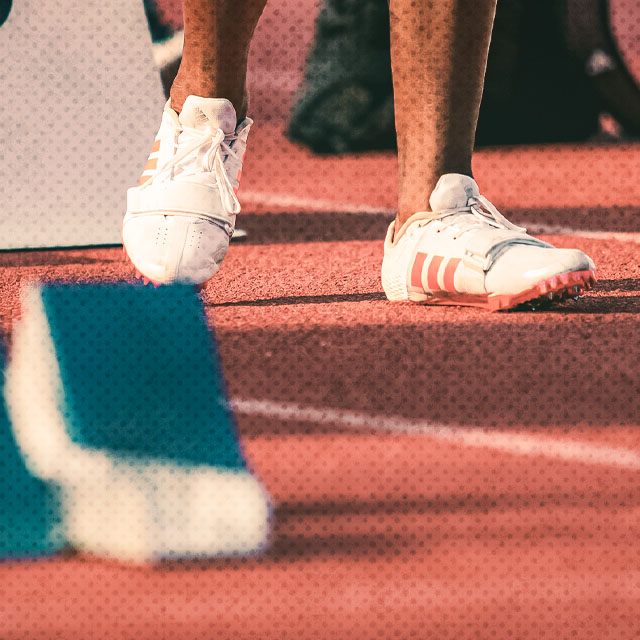5. Stretching Before Training is a Bad Idea
There's a moment before every workout when otherwise smart athletes do something profoundly dumb: they grab an ankle, yank it to the glute, and hold. And hold. And hold.
It feels right. It isn't.
The evidence is hard to ignore. Meta-analysis after meta-analysis shows that holding a static stretch for about a minute causes your next explosive effort to fall by roughly
4–7% on average. A fresh 2025 study in the Journal of Sports Science & Medicinebacks that up: one 60-second lower-body stretch was enough to lower squat-jump height and disrupt early-phase muscle activation.
Here's the insulting part:
static stretching flips your nervous system into relax mode, lowering muscle-tendon stiffness and slowing your firing rate, the exact opposite of what sprinting demands.
The fix: Skip the static holds and go straight into dynamic drills and a proper three-step warm-up. For a full step-by-step routine you can use today, check out our guide:
Track and Field Warm-Up Routine.4. How sound cues improve reaction time and power
Here's something they don't teach at coaching clinics: the starter's gun isn't just a timekeeper. It's a performance enhancer.
We obsess over block angles, shin positions, first-step mechanics. But there is another element that consistently makes athletes move faster: the sound at the start.
This isn't motivational nonsense. When researchers studied auditory-motor priming (how sound affects movement), they discovered something remarkable: a sharp, loud sound at the moment of initiation doesn't just start the race. It literally makes muscles fire harder and faster.
The effect is immediate and measurable. Reaction times drop. Rate of force development spikes. Your nervous system, it turns out, has been waiting its whole life for someone to yell at it properly.
The takeaway: Stop practicing starts in library silence or with a subtle cue. Have someone clap, loud, sharp, sudden at the exact moment you explode. Box jumps, med ball throws, block starts. Train your nervous system to expect noise and respond with violence
3. Hill Sprints Build Serious Speed (When Done Right)
Every coach knows hill sprints build fitness, character, and mental toughness. Ask any athlete about hills and they'll tell you about burning lungs, jelly legs, and the peculiar suffering that comes from a hill workout.
What they don't know is that the biggest benefit has nothing to do with any of that. It's pure speed. And by chasing the suffering, we've been leaving the speed gains on the table.
A randomized study published in Scientific Reports (July 2025) put 16-20 year old subjects through eight weeks of steep hill work (7.6 % grade, 3–4 sets × 6–10 reps of 30–90 s with full recoveries). Their flying-30 m velocity improved 0.93 m s compared with controls, roughly a 0.4-second drop for someone who covers 30 m in four seconds.
In our sport, that's a full stride ahead which is the difference between winning and explaining why you didn't.
The biomechanics are elegant. Hills force the exact forward lean and horizontal drive you need for acceleration. It's like having gravity teach you proper mechanics.
But when you run hills to exhaustion, you're teaching your body to survive, not sprint. The science says keep it under 30 meters, take full recovery. Power, not pain.
The fix: Short hills. Full rest. Think acceleration, not conditioning. The mental toughness will come anyway, but now with speed attached.
2. The Neurological "Glitch" That Makes Two Legs Weaker Than One
Picture a third-grade math problem: your right leg can push 125 pounds, your left leg can push 125 pounds, so together they should push…250.
They don't. Most athletes hit 188-225 pounds, a mysterious 10-25% loss that fascinates neuroscientists.
Scientists call it the bilateral deficit. When both legs fire simultaneously, your brain puts itself on a conference call with both hemispheres, and like most conference calls, nobody performs at their best. The motor cortex dials back the signal through inter-hemispheric inhibition, a built-in governor that assumes you can't be trusted with all your power at once.
Elite sprinters and jumpers have been accidentally gaming this system for years. Every split squat, every single-leg bound: one hemisphere gets to send its full-strength signal without interference.
The research is overwhelming: unilateral training produces larger gains in acceleration, jump height, and change-of-direction speed than bilateral work alone. But you don't have to choose. Train single-leg to unlock the force, then return to bilateral moves to harvest it.
The fix: Make single-leg work a primary focus at least once a week. Split squats, single-leg RDLs, power step-ups. You're not replacing your bilateral lifts. You're teaching your nervous system to stop holding them back.
1. The 5-Second Lift That Makes Throwers, Jumpers and Sprinters Perform Better
What if I told you that lifting something incredibly heavy right before you compete could make you faster, throw farther, or jump higher?
It sounds like sabotage. It's actually science.
Before major competitions, Ryan Crouser squats over 700 pounds, then throws for gold minutes later. He's not showing off. He's using physiology.
Recent meta-analyses confirm what elites have discovered: one heavy back squat, performed 8-12 minutes before competition, improves performance by 1-3%. Sprinters run faster. Jumpers add inches. Throwers gain distance. All from post-activation performance enhancement.
Here's the mechanism: that 85-90% load wakes up your highest-threshold motor units, the ones that sleep through normal warm-ups. It floods your muscles with calcium, primes your nervous system, and announces that serious business is about to happen.
The protocol is precise: One explosive rep at 85-90% of your max. Walk away. Active recovery for 8-12 minutes. Then compete while your nervous system is firing on all cylinders.
The requirements: You need real strength first (2x bodyweight squat minimum). Timing is non-negotiable. Too early and it fades, too late and you're fatigued. Resist the urge to do more. Additional reps create fatigue.
Important note: This is experimental territory. While the research is promising, we don't personally know sprinters who have successfully used this protocol before track meets.
